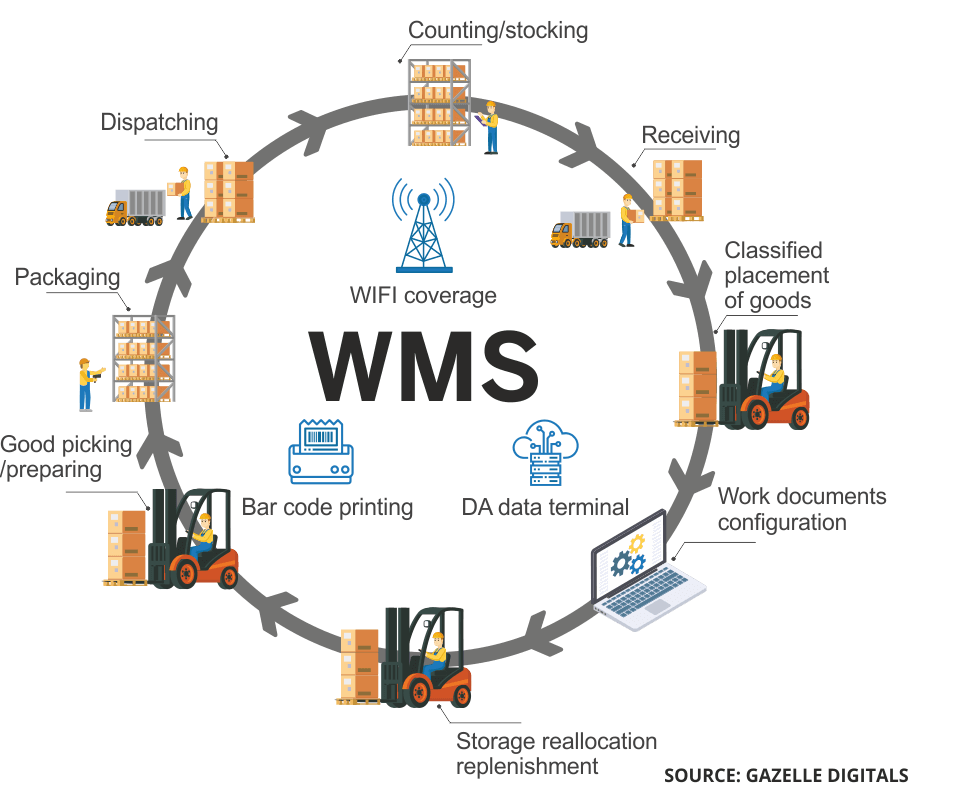A warehouse management system has transformed business work by simplifying processes, reducing expenses, and improving efficiencies. In the era of competitive markets, a warehouse management system is essential for inventory control, shipping, receiving, and order fulfillment. Various businesses want to develop their Warehouse management systems; however, they need help implementing WMS specifically because they are grappling with the question of warehouse management system cost. Now, there is no more grappling. This article will provide the complete warehouse management systems costing guidelines and their comprehensive features, types, and examples. Let’s dive into the article and learn about it.
Warehouse Management System Cost
The WMS development cost can vary depending on various factors, such as the size of the business, deployment model (Cloud, on-premise, or hybrid), features, Budget, and the service provider selected. Basically, cloud-based WMS software has lower upfront costs and ongoing monthly fees, while on-premise WMS might have higher upfront costs because of its hardware and software licensing requirements.
The average cost of cloud-based warehouse management systems ranges from $50 to $200 per month per user, translating to an annual fee of $500 to $2500 per user. On the other hand, the cost of on-premise WMS software can range from $10k to $100k, depending on the business size and user count.
The warehouse management system cost includes various vital components such as integration with the current ERP, initial setup, support costs, customization if needed to meet the business needs, employee training, and go-live support to ensure a smooth transition to the new system. WMS implementation cost can vary from various factors, such as the warehouse size, the operation’s complexity, and the required features and functionality, but typically costs $50,000 or more.
Furthermore, businesses may also need to consider the maintenance and upgrade costs, besides the cost of implementation associated with a WMS, which can vary depending on the service provider and development model. Let’s take an example: The annual maintenance costs for a cloud-based right WMS software can start from $1k to $ 10k, whereas upgrade costs for an on-premise WMS software may start from $5k to $50k.
Other Factors that Affect Warehouse Management Systems’ Costing

There are various factors, including complexity level, company size, location, hourly rate, testing, etc, that affect the Warehouse Management Systems Costing. Let’s know about some more factors that affect the cost of WMS.
WMS Development Cost as per Company Size
| Size of the Company | Cost as per size |
| Small-Size Company | $2,000 to $ 25,000 |
| Medium-Size Company | $30,000 – $45,000 |
| Large-Size Company | $50,000 – $95,000 or more |
WMS Development Cost as per Company Location
| Different Regions | Hourly Cost of the Developers |
| United States (US) | $140/hr |
| Eastern Europe | $80/hr |
| Australia | $90/hr |
| South Asia | $25/hr |
| India | $45/hr |
WMS Development Cost—Based on Industries
| Industries | Approx, WMS Development Cost |
| Manufacturing Industry | $100 – $150 |
| Healthcare Industry | $120 – $170 |
| Third-Party logistic companies | $110 – $160 |
| Wholesale distributors | $90 – $140 |
| Consumer Goods and Retail | $95 – $145 |
License Type and Cost
There are two types of license: Perpetual and Subscription. Let’s briefly discuss both types of licenses.
Perpetual Licenses: This model involves purchasing software outright and paying for annual upgrades made by organizations. It requires a license fee, an up-front customization fee, and a yearly maintenance fee. 1 WMS license fees generally start from $25000 to $50k to $100k, and annual maintenance fees typically cost 10% to 15% of the license costs.
Subscription License: This is the most famous type of purchase for WMS solutions. It provides more frequent updates and requires lower up-front fees. The monthly cost generally varies and is reasonable depending on the business size and users using the system. It can range from $200 to $800 per month and up to $5000.
Key Features that can be included in the warehouse management system
Here are the must-have features for a successful warehouse management system. Let’s know about the comprehensive features:
Inventory Management
Inventory Management provides the live tracking of inventory levels and allows warehouse managers to accurately monitor stock quantities and locations.
Order Management
Order management integration helps handle online orders efficiently. It includes managing returns and exchanges and helping warehouse management staff process accurate and quick transactions.
Barcode and RFID Scanning
To improve the speed and accuracy of warehouse operations, barcode and RFID scanning must be supported. These technologies are also capable of the receiving, picking, packing, and shipping process and make warehouse work more quick.
Reporting and Analytics
These features offer detailed insights into inventory levels, order status, and warehouse performance. It allows warehouse managers to analyze trends, forecast demands, and monitor key performance indicators (KPIs)
Integration Capabilities
A warehouse management system must be compatible with other important business systems, such as CRM and ERP, to ensure seamless operations. Apex Power Dialer effectively integrates with CRM, ERP, and WMS systems, streamlining communication, automating calls, enhancing customer service, and providing valuable analytics for optimized warehouse operations.
User-Friendly Interface
The WMS must adopt a successful, User-friendly interface. It must have an intuitive and easy-to-navigate design, allowing users to perform tasks efficiently and quickly.
Types of Warehouse Management Software
Generally, there are various types of warehouse management software, but in this article, we will discuss four types of WMS: Cloud-based, on-premise, hybrid hosting, and ERP integrated. Let us know about them briefly.
Cloud-Based
This is cheaper Warehouse Management Software. With cloud development (SAAS), there is no additional cost of having someone on site. There is no server to maintain, and access is available whenever and wherever needed. Generally, cloud-based WMS development includes an annual or 6-month fee. The monthly fee may start from $1500 per month.
On-Premise
This method is widely used in businesses. It can be expensive, though the longer-term costs may end up being lower. The license costs $75,000, and the initial setup fee is $20,000. The annual maintenance fee is 10 to 15% of the license cost ($7,500-$11,250). This is expensive, but over time, it becomes cheaper than cloud development.
Hybrid Hosting
Hybrid hosting uses an on-premise server to communicate with a virtual private server in the cloud, making it a famous supply chain solution. This helps with recovery, backups, and scaling up during heavy loads. The con of hybrid hosting is that it comes with many of the same issues that are faced with on-premise servers since it still needs servers and needs to buy the perpetual license for the on-premise servers. This is the mixture of cloud and on-premise; develop this software and pay for the combination of on-premise and cloud warehouse management system costs.
ERP Integrated
ERP Integrated software is a powerful combination of many other systems that offer most core apps that streamline 3PL processes, such as supply chain planning, Procurement, Accounting, Customer relationship management, and Human Resources. Although the ERP Integrated warehouse management system cost may double due to its unique features, it is the best fit for those dissatisfied with other software solutions and want a centralized system.
Warehouse Management System Examples
Here are the best warehouse management system examples that will help to know more about it. Let’s explore!!
Oracle Warehouse Management
Oracle WMS is one of the best warehouse management system examples. It is a cloud-based platform that provides solutions for all sizes of businesses. It has flexible modules to optimize inventory operations, complex fulfillment, and cost reduction.
Top benefits of Oracle Warehouse Management
- Increase Visibility
- Reduce Errors
- Strengthen Customer Service
- Improve Reporting
Features of Oracle Warehouse Management
- Kitting and De-Kitting
- Shelf Life Monitoring
- Work Order Management
- Batch Picking
Microsoft Dynamics 365
Microsoft Dynamics 365 is another best warehouse management system example and cloud-based solution. It offers specialized ERP integration for supply chain management and unique modules to meet real-time customer demands and increase productivity.
Top Benefits of Microsoft Dynamics 365
- Reduce Downtime
- Improve Warehouse Management
- Optimize Costs
- Strength Demand Forecasting
Key Features of Microsoft Dynamics 365
- IoT Fleet Monitoring
- Inventory Analytics
- Returns Management
- Transportation Planning
Logiwa WMS
Logiwa WMS is one of the leading warehouse management system examples that provides a solution for small —and medium-sized businesses. It is a cloud-based WMS that provides B2B shippers, 3PLs, online brands, and eCommerce clients with integrated modules to increase upscale delivery operations and sales.
Top Benefits of Logiwa WMS
- Streamline Integration
- Increase Automation
- Strengthen Operations
- Boost Visibility
Key Features of Logiwa WMS
- Pick and Pack
- Barcode Scanning
- Master Data Management
- Cross Docking
- Kitting
Fishbowl Warehouse Management System
Fishbown WMS is an integrated leading solution for all sizes of businesses and one of the best warehouse management system examples. It optimizes and streamlines warehouses with modules including purchasing tracking, order management, and shipping.
Top Benefits of Fishbown WMS
- Boost productivity
- Facilitate Currency Centralization
- Optimize Integration
- Improve Accessibility
Key Features of Fishbown WMS
- Barcode Scanning
- Shipping Management
- Cycle Counting
- Serial and Lot Tracking
- Inventory Recording
Sum Up
At last, hope you learned about the warehouse management system cost, its examples, and its types. As mentioned above, the warehouse management systems costing is rough and estimated. It may be affected by various factors, such as choosing a service provider, location, features, and other integrations. Now, it’s time to make changes to your business; WMS is one of the best options to put your business at its peak by using the latest and modern technologies of Warehouse Management Systems.

